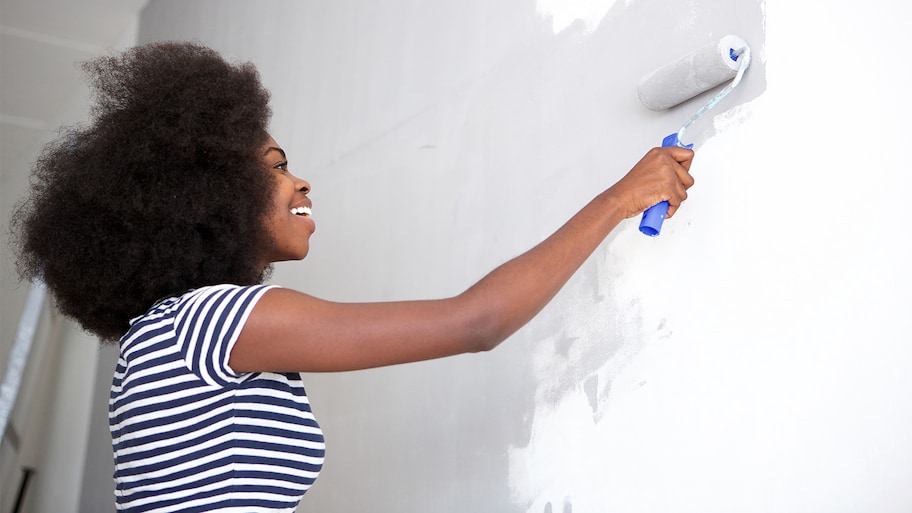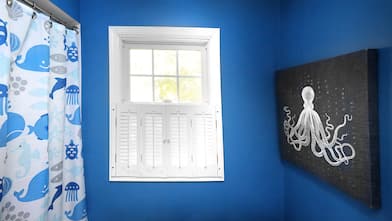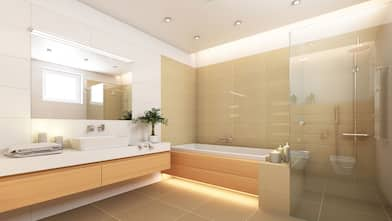These seven vital factors determine how many years your paint will last
Paint on your interior walls gives your space a brand new vibe and lifts your mood after a long day, while painting the exterior of your home maximizes and accentuates your curb appeal. But many good things fade with time, and you may wonder how long a paint job will last.
You should paint your house anywhere between every three to 10 years, depending on the surface type, paint type, and location. From paint color to paint quality to preparation and, of course, Mother Nature, here’s a look at every aspect that affects your paint job’s longevity.
How Often Should I Paint My House?
On average, you should paint your house every four to six years, but some surfaces may need to be painted every three years, while other surfaces can get away with a paint job every 10 years.
7 Signs You Need to Repaint Your Home’s Exterior
When it comes to repainting your home’s exterior, there comes a time when you can’t follow the whole “out of sight, out of mind” mentality. Here are a few eyesores that might tip you off to that need for a new paint job.
1. Cracked and Peeling Paint
Cracked and peeling paint are classic signs that your house needs some TLC. Remember that where there’s a crack, there’s a potential for your home to get exposed to Mother Nature. From rain to snow, your best bet is to repaint your home before weather damage causes costly repair projects.
2. Bubbling Paint
Bubbling paint could be a sign that you have a water leak. In this case, you’ll want to assess the damage and repaint the wood ASAP to prevent mold and rot.
3. Mold Damage
If the damage has already been done, you might see mildew spots or mold damage. Before you can repaint your surface, you may need to replace decayed wood.
4. Cracked or Missing Caulking
Caulking is a sneaky issue that might not be obvious at a quick glance. That’s why it’s a good idea to look closely at your paint job every few years for signs of cracked or broken caulking, as air or water can seep through these little spaces.
5. Faded Colors
If seeing your home after a long outing doesn’t give you the same sigh of relief that it used to, your paint may be to blame. Lackluster colors on your once vibrant home are another sign that your exterior needs a paint makeover.
6. Selling Your House
Let’s face it: looks matter, and when it comes to selling your house, you don’t want to risk having your home visually stand out in all the worst ways. Interior and exterior paint jobs are an effective way to improve the appearance of your home and make it more sellable. Add a fresh coat of paint to
7. Weather Damage
Weather also shortens the life of the paint. Regions prone to heavy, direct sunlight, moisture, and high humidity make your exterior paint job fade and peel faster. But remember, nature’s UV rays (highest around noon) can also enter homes through windows which not only fade paint but your floors and artwork, too.
Paint Tip: Install room darkening blinds or shades on windows that get direct sun.
6 Signs You Need to Repaint Your Interior
Your home’s interior may show different signs than the exterior. After all, you have to live with the colors of your home nearly every day! Check out these signs to find out when your interior could use a little sprucing up.
1. Cracked Paint
Like with the exterior of your home, cracked paint inside can be a sign that it’s time to whip out the old paint cans. However, you might want to rule out a foundational problem before you start painting to prevent further cracks.
2. Faded Colors
The inside of your home can also show signs of fading, especially if the walls receive high amounts of sunlight.
3. Personal Preference
Whether you’ve just moved in or simply grown tired of the same-old, same-old, personalities change. And your home’s walls might just need to change with you!
4. Wear and Tear
Avid DIYers may have many holes or scuff marks on the walls from projects. Signs of wear and tear can impact the overall look of your home, so consider touching it up to brighten up the space.
5. Water Marks
Water damage leaves ugly stains behind—even if you were proactive about preventing mold growth. Before you paint over water splotches, consider having a pro inspect your home just in case any mold snuck into the walls.
6. Foot Traffic

The life of your paint depends on the amount of foot traffic in your home. Paint in high-traffic areas like kitchens and bathrooms tends to fade and chip quicker than spaces with less traffic like spare bedrooms and home offices.
Reasons why your paint fades, peels, and chips include:
Humidity and water from daily showering and washing
Grease splatter and steam from cooking
Handprints on walls in high-traffic areas like stairways
Heavy traffic where kids and pets run and play like hallways and kids’ rooms
Paint Tip: Keep windows and vents open while bathing and use washable paint that stands up to children and pets.
What Impacts Your Paint’s Lifespan
No two paint jobs are exactly the same, and their lifespans won’t be, either.
1. Type of Surface
The type of surface you paint (and the type of paint you use) affects your paint job’s longevity, too. Wood has a shorter lifespan (five to seven years) and can wear faster than painted brick or stucco, lasting up to 10 years or longer. Paint surfaces include:
Wood
Metal
Stucco
Brick
Stone
Cement
Drywall
Paint Tip: Use paint formulated for the surface you’re painting for the best results.
2. Paint Quality
Better quality paints contain a higher percentage of quality raw materials (solids, pigments, and resins), increasing paint performance. For example, a higher volume of solids allows more of the paint to adhere to the wall after the liquid evaporates. Although these paints cost more per gallon, they offer more coverage and a better application than cheaper paints.
Paint Tip: Aim for somewhere in the middle when you don’t have the budget for the best quality paint.
3. Paint Color

Another factor that affects paint durability is color. Darker paint colors fade faster than lighter shades, especially on the exterior of your home. Although light colors won’t fade as fast as darker hues, they show scuffs and blemishes with time.
Paint tip: To avoid paint fading outdoors, select inorganic earth tone colors in the beige and brown families.
4. Paint Sheen
Using the appropriate paint sheen will preserve your paint’s life; bathrooms with high humidity and steam require semi-gloss or gloss. The same goes for trim, molding, and baseboards. Flat and matte paints are harder to clean than eggshell, semi-gloss, and high-gloss sheens.
Paint Tip: When painting trim, tape off the walls and ceiling borders to protect the walls.
5. Preparation
Properly preparing your paint surface is another key component of getting a long-lasting paint finish. If the last person who painted did a sloppy job, you may need to sand off the old paint and do some repairs. Other preparation steps include:
Dusting and cleaning surface areas
Scraping loose paint off interior and exterior walls
Stripping exterior paint when caked on too thick
Filling nail holes and gaps with spackle and caulk
Priming for a better paint application
Sealing window edges
Local expert painters know ignoring prep can cause your paint to fade, bubble, blister, peel, and crack. When this happens, it will cost between $360 to $1,170 to repair the damage.
Paint Tip: Keep the walls clean and interior temperature cool and dry to avoid the paint from forming blisters and bubbles.
6. Primer Application
A good application is essential to ensure your paint lasts longer—and that application begins with a primer. Don’t skip this step, or you may need to repaint in a few months.
Reasons to prime:
It’s an unpainted surface
Changing wall colors and sheens
After wall repair and patching
Painting a lighter shade over a darker color
Painting rooms prone to moisture like bathrooms
Painting walls with water stains or smoke damage
Sometimes one coat of primer will do, but stubborn surfaces and slightly challenging projects, like painting vinyl siding, will require two more or more coats.
Paint Tip: When priming, use a spotlight to ensure you hit all the corners evenly.
Consider Hiring a Pro to Make Your Paint Job Last Longer
While some DIY enthusiasts enjoy painting projects, qualified painting pros have the right tools and expertise to ensure your paint job lasts for years. When hiring a painter, here’s what you’ll pay, depending on the amount of labor required and the area where you live:
$25 to $100 per hour
$300 to $750 for a 10-by-12 room
$2 to $6 per square foot
Exterior paint jobs cost more than interior painting. The cost to paint a home’s exterior is around $3,000 in total on average, while painting a home’s interior costs around $1,900 on average if you hire a professional painter.
Before you decide on your pro, interview a minimum of three experts to learn their process, and be sure to check out reviews before you hire a local painter. Also, view their work so that you can choose the right painting professional for a long-lasting flawless finish.

 - Allie Ogletree.jpeg?impolicy=thumbnail)



